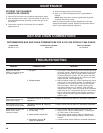
16
UK
MAINTAINING DEPTH GAUGE CLEARANCE
See Figures 51, 59, and 60.
■ Maintain the depth gauge (A) at a clearance of 0.6 mm
(0.025 in.). Use a depth gauge tool for checking the depth
gauge clearances.
■ Every time the chain is filed, check the depth gauge
clearance.
■ Use a flat file (B) (not provided) and a depth gauge jointer (C)
(not provided) to lower all gauges uniformly. Use a 0.6 mm
(0.025 in.) depth gauge jointer. After lowering each depth
gauge, restore original shape by rounding the front (D). Be
careful not to damage adjoining drive links with the edge of
the file.
■ Depth gauges must be adjusted with the flat file in the same
direction the adjoining cutter was filed with the round file.
Use care not to contact cutter face with flat file when
adjusting depth gauges.
MAINTAINING THE GUIDE BAR
See Figure 61.
CAUTION:
Make sure the chain has stopped before you do any work
on the saw.
Every week of use, reverse the guide bar on the saw to
distribute the wear for maximum bar life.The bar should be
cleaned every day of use and checked for wear and damage.
Feathering or burring of the bar rails is a normal process of bar
wear. Such faults should be smoothed with a file as soon as
they occur.
A bar with any of the following faults should be replaced:
■ Wear inside the bar rails that permits the chain to lie over
sideways
■ Bent guide bar
■ Cracked or broken rails
■ Spread rails
In addition, lubricate guide bars (with a sprocket at their tip)
weekly. Using a grease syringe, lubricate weekly in the
lubricating hole.
Turn the guide bar and check that the lubrication holes (A) and
chain groove are free from impurities.
MAINTAINING THE SAFE-T-TIP® NOSE
GUARD
See Figures 62 and 63.
CAUTION:
Make sure the chain has stopped before you do any work
on the saw.
WARNING:
Although the guide bar comes with a SAFE-T-TIP®
anti-kick-back device already installed, you need to check
the tightness of the mounting screw before each use.
Tighten the mounting screw (A) of the nose guard as instructed
below. These are specially hardened screws. If you cannot
install the screw tightly, replace both the screw and the
SAFE-T-TIP® (B) before further operation. Do not replace the
screw with an ordinary screw.
In addition to preventing chain contact with solid objects at the
nose of the bar, the SAFE-T-TIP® also helps keep the chain
away from abrasive surfaces, such as the ground. Keep it on
the right-hand side of the bar where it will be between the
chain and the ground during flush with ground cutting.
The mounting screw requires a 5/16 in. spanner (or adjustable
spanner) to achieve the recommended tightness of 4-5 Nm
(35 - 45 in. lb.). A tightness within this range can be achieved
by using the following method.
1. Tighten the screw with your finger.
2. Tighten the screw an additional 3/4 of a turn using
a spanner (C).
MOUNTING THE SAFE-T-TIP® NOSE GUARD
See Figures 62 and 63.
1. Mount the SAFE-T-TIP® on the bar nose.
2. Fit the locking rivet or tab in the recessed hole in the
guide bar.
3. Tighten the screw with your finger.
4. From the finger tight position, tighten the screw an additional
3/4 of a turn using a spanner.
CLEANING THE AIR FILTER
See Figures 64, 65, and 66.
NOTE: Always clean the air filter before making any mixture
adjustments of the carburettor.
1. For access to the air filter and carburettor area, loosen the
three screws (A) holding the cylinder cover (B).
2. Activate chain brake.
3. Lift the front of the cylinder cover past chain brake lever.
4. Lift the back of the cylinder cover past the handle.
5. Before removing the air filter from the carburettor, blow or
brush as much loose dirt and sawdust from around the
carburettor and chamber as possible.
NOTE: Be sure to pull the choke rod out to keep the
carburettor from being contaminated.
6. Remove the screw (C) securing the air filter (D).
7. Position a flat screw driver between the tabs and twist as
shown in the illustration.
8. Lift the air filter off the air filter base.
MAINTENANCE


















